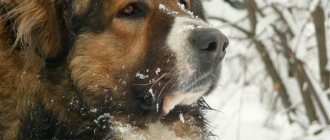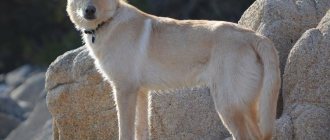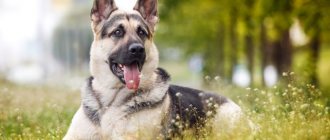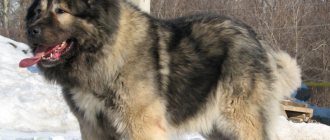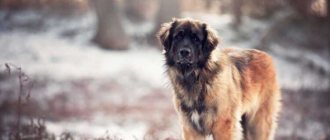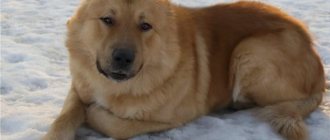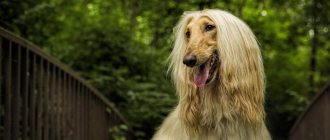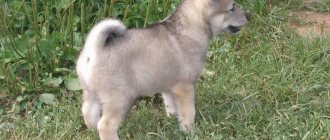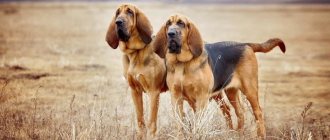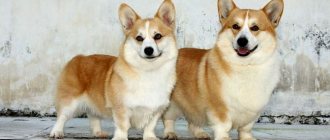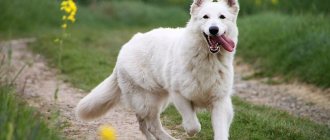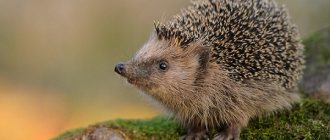The Caucasian Shepherd Dog is one of the largest shepherd dogs on Earth, second in size only to the Central Asian ones. Representatives of the breed have established themselves as shepherds and excellent guards. They quickly react to the danger that threatens the owner and rush to his defense, turning from a calm and balanced dog into an angry beast. Let's find out what future owners of Caucasians can expect from this breed.
Description of the Caucasian Shepherd breed
Popularity 218th place among 263 dog breeds
Lifespan:
10-11 years
Breed group:
Sentinels
Height:
males: 68-75 cm, females: 64-71 cm
Country of origin:
Russia
Average price:
25-35 thousand rubles
Weight:
males: 50-75 kg, females: 45-70 kg
Latest articles Cat health
Ataxia in cats: what it is, how it manifests itself and is treated 01/23/2022 151 0 0
Cat health
Leukemia, or viral leukemia in cats 01/23/2022 140 0 0
Puppy weight and sizes for male and female from 1 to 12 months
Keeping track of your pet's weight and height is an essential part of owning a dog. It is important because without this surveillance you will not be able to notice deviations in the development of the dog.
Indifference in this regard can turn out to be disastrous, because often when a puppy lags behind its peers in physical development, this can indicate serious health problems.
| Dog's age (in months) | Male weight (grams) | Bitch weight (grams) | Male height (cm) | Bitch height (cm) |
| 1 | 4000-6800 | 2500-4500 | 24-26 | 23-25 |
| 2 | 13000-19600 | 11500-18000 | 34-37,5 | 33-35,5 |
| 3 | 18000-32000 | 165000-30000 | 45-49 | 43-46 |
| 4 | 25000-60000 | 22000-50000 | 51-55,5 | 48,5-51,5 |
| 5 | 35000-64000 | 32000-60000 | 57-62,5 | 54-57 |
| 6 | 40000-94000 | 35000-92000 | 63-68 | 59-63 |
| 7 | 41700-99000 | 35700-96200 | 64-70 | 60-65 |
| 8 | 43400-104400 | 36500-100600 | 65-72 | 61-67 |
| 9 | 44800-109500 | 37200-104800 | 66-74 | 62-69 |
| 10 | 46200-114600 | 38000-109000 | 66,5-75 | 63-70 |
| 11 | 47600-125000 | 38600-113200 | 67,5-76 | 63,5-71 |
| 12 | 50000-125000 | 40000-115000 | 68-78 | 64-72 |
Advantages and disadvantages
- Pros:
- an excellent security guard who can live outside all year round;
- can get along in an apartment with sufficient walking;
- balanced nervous system and calmness;
- ease of training and socialization;
- unpretentious in care and feeding.
- Minuses:
- requires a strong-willed character from the owner;
- sometimes guards the owners’ home too carefully;
- needs walks if he does not have a spacious enclosure.
Limbs
The forelimbs are perpendicular to the ground and are relatively far apart. Muscles are physically developed. Strong, close-fitting shoulders to the chest, together with wide shoulder blades, form an angle of one hundred degrees. The elbow joints are parallel to the surface and directed straight back. Short pasterns have an almost straight structure.
If you look at the dog from behind, you will see that the hind legs are perpendicular to the ground and are moderately far apart. The clearly visible hock and stifle joints are at an angle of one hundred and fifty degrees. The thighs, shins and metatarsals are well developed physically.
All limbs end in large rounded paws.
Key facts
The Caucasian's country of origin is Russia. An image of this species is found on some coats of arms of Georgian princes. The modern description of the Caucasian Shepherd breed says that in Russia a large number of breeding nurseries are engaged in professional breeding.
If you want to make such a friend, you need to consider some points. For example, Caucasians perceive only members of the family in which they live. They treat all other people quite unkindly. The animal instantly reacts to any potential danger, so when walking it, you always need to be on alert. The characteristics of the Caucasian Shepherd dog breed emphasize that the dog needs strict education under the guidance of a strong-willed owner.
You should refuse the purchase if you have never dealt with large dogs before, and also if you cannot visit training grounds with your dog.
Representatives of this type are fully formed by the age of two, both physically and mentally. This fact should definitely be taken into account when taking a course with a dog handler. This species is highly trainable and has excellent working qualities. In a fit of anger, it is almost impossible to restrain a dog; at these moments they become angrier than pit bulls and Staffords, which is very dangerous, given the size of the dog.
Caucasians belong to the category of giants. Weight ranges from 45-50 kg for females, from 50 to 60 kg for males. Dimensions of the Caucasian Shepherd at the withers: up to 70 cm for females, up to 74 cm for males. The average life expectancy of a Caucasian Shepherd is 15 years, and long-livers are common.
How to choose? Boy or girl?
Comparison of all the advantages and disadvantages of males and females will help you decide on the sex of your pet.
Pros of a male:
- The breed's characteristics are more pronounced than those of the female.
- There are no heats or related problems.
Cons of a male dog:
- Without proper attention, he can go after any female in heat.
- Marks territory.
- Shows greater independence from the owner than the bitch.
- They are stubborn and difficult to train.
Pros of a bitch:
- More devoted to the owner than males.
- They don't mark their territory.
- They can bring offspring, and as a result, profit.
Cons of a bitch:
- Estrus and the need to protect the bitch from admirers.
- Females are more aggressive towards strangers.
History of the origin of the Caucasian Shepherd
There is no consensus on when and from which ancestors this subspecies was obtained. Most scientists have come to the conclusion that the closest relative of the Caucasian Shepherd is the Tibetan Mastiff or Tibetan Great Dane. Russia is considered the country of origin.
According to another version, animals first appeared in the ancient state of Urartu, located in the Caucasus. Images were discovered that vaguely resembled these watchdogs.
Interesting Facts:
- The first chronicle mention of this breed dates back to 1121 BC, when the emperor of the Zhou dynasty received a puppy as a gift;
- in 1765, an official order was issued in Russia, which obliges the owners of Caucasians to involve them in guard and security service;
- in the 19th century they tried to use this species for search purposes, but the experiment failed, and German and East European shepherds replaced Caucasians;
- Animals are often given intimidating nicknames, which is facilitated by their menacing appearance.
Owning a Caucasian watchman is a big responsibility, since a dog that is not raised correctly can be aggressive and dangerous.
Appearance of the Caucasian Shepherd
General impressions
In addition to the single standard described by the Russian Cynological Federation, there are several subtypes that have slight visual and behavioral differences among themselves:
- Georgian - these dogs are stronger and more massive, the body length is several centimeters longer than other species, the coat is long, of the same shade, most often zone-gray;
- Armenian - are the smallest individuals,
- mountain Azerbaijani and steppe Azerbaijani;
- Dagestan - resembles Georgian, but has a bicolor or tricolor color.
The first standard was registered in 1931. It is based on the Georgian type of animals.
It is interesting that for two years in a row, in 1970-1971, the title of World Champion at the International Exhibition was awarded to Caucasians. The photo of the Caucasian Shepherd shows that in front of you is a representative of a giant breed.
Head
The head with a square forehead is massive. The cheekbones are well developed and have clear outlines. The muzzle is large, blunt in shape. Convex forehead with a shallow groove. The lips are thick and close tightly. The color of the nose is black, for light colors brown is acceptable. The ears are not large and stop within a few days after birth. It is worth remembering that if you plan to attend foreign exhibitions with your dog, it is better not to crop the ears, since according to the new international rules this operation is prohibited. The eyes are deep-set, dark in color, the eyelids fit tightly to the eyeball. The bite is standard, scissor-shaped. Number of teeth – 42 pieces.
Neck
The neck of dogs of this breed is powerful, muscular, and strong. The scruff is clearly defined. Significantly shorter than the length of the skull bones. The angle relative to the dorsal line is 30-40 degrees. A slight “suspension” is acceptable, but practice shows that such dogs rarely receive prizes at exhibitions.
Torso
The sternum is wide, low-set, round in shape. The lowest point of the chest should be at the level of the dog's elbows. The belly is lean. The withers protrude significantly above the line of the back and are wide. The back is straight, level, the croup is slightly sloping. The back muscles are strong and wide. The loin is shortened in males, a slight lengthening in females is acceptable.
Forelegs
The paws are powerful, the pasterns are strong, stable, and short. When examining the forelimbs from the front, you can see that the paws are widely spaced, straight, parallel to each other. Elbows are pulled back, and deviation to the side is considered a violation of the standard.
Hind limbs
The hind limbs are parallel to each other. The hock joints are slightly straightened. When the dog is standing, the feet are brought out under the hock joint, forming a 90-degree angle. Pulling back the hind legs is unacceptable.
Tail
The tail is set high, sickle or ring shaped, relaxed when calm. The tip of the tail reaches the hock joint.
Movements
The movements are not constrained, the main gaits are slow - a walk or a wide slow trot. With active movements, a heavy gallop without signs of instability is acceptable. The front legs do not cross the midline when running. The tops of the croup and withers should be at the same level. During active movements, the dog does not rake the soil with its paws and does not deviate from the straight path of movement. The elbow joints do not turn outward when moving. The paws should spring slightly when pushing.
Wool
The coat of this breed is thick and thick. This is due to the fact that the Caucasian Shepherd Dog at one time adapted to the climatic conditions of the mountainous regions of the Caucasus. Three-layer wool:
- the top layer retains moisture from the outside;
- spinous layer,
- the undercoat stores heat under the fur
Based on which of the three layers predominates, there are short-haired types, long-haired types and intermediate ones.
Color
Acceptable colors of the Caucasian Shepherd according to the FCI breed standard: any solid solid color, any spotted color. It is unacceptable if the Caucasian Shepherd is uniformly black, brick brown, genetically blue, or unexpressed black. The most common colors are red, grey, brindle and white. The dog's eyelids and lips should have a bright black continuous outline.
Size
The height of a Caucasian Shepherd Dog at the withers should be at least 68 cm and not exceed 75 cm for males. The optimal height is 70-72 cm. The female should not be lower than 64 cm, but also not exceed the limit of 70 cm. The weight of a Caucasian shepherd dog should not fall below 50 kg, and a female shepherd dog should not fall below 45 kg.
Any deviation from the official breed standard may reduce the show score. Disqualifying defects do not give the dog the right to participate in national and foreign exhibitions.
Popular types
Based on the type of coat, Caucasian Shepherd Dogs are divided into long-haired, intermediate-haired and short-haired.
In total there are the following types of this dog breed::
- Shorthair . They are distinguished by their extraordinary courage and at the same time aggressiveness; they are not afraid to fight a wolf alone. However, due to the fact that their coat is shorter than that of the standard variety, they do not tolerate extreme cold very well.
- Smooth-haired . Due to the very short undercoat, they resemble Central Asian Shepherds in appearance.
- Stepnaya . Bred mainly in Azerbaijan and Dagestan. It is distinguished by a lighter type of build and high legs. They are famous for their speed and swiftness. As a rule, their short fur is colored in reddish shades.
- North Caucasian . It is distinguished by physical strength, endurance and the ability to adapt to the most difficult weather conditions. The character is characterized by decisiveness, distrust of strangers and independence in decision-making.
- Bald . In the 70-80s of the 20th century, the so-called hairless Caucasian Shepherd Dogs were bred, whose fur did not exceed 5-6 mm in length. The purpose of breeding a hairless variety was an attempt to adapt the Caucasian Shepherd to urban conditions, since the classic long-haired variety would have too much hair in the apartment, and the dog itself would not be comfortable due to the heat. It is considered a subspecies of short-haired dogs.
The most common colors in dogs of any type are gray, red, fawn, brown and white , brindle and motley Caucasian Shepherds are also found .
Personality of the Caucasian Shepherd
Who is the Caucasian Shepherd Dog suitable for? The breed has a very difficult character. That is why it is not recommended to get one for people who do not have experience with large breeds. Caucasian Shepherds are distinguished by their persistence, stubbornness, and fearlessness.
Dogs have excellent watchdog qualities. They are unpretentious in maintenance, preferring outdoor enclosures to apartment keeping or indoor living. In winter they do not freeze outside due to their thick undercoat.
The breed treats children quite well, but does not show active interest or sympathy. But if there is a child in the family where the Caucasian lives, perhaps he will become number one for the dog. These dogs are monogamous by nature and recognize only one owner, perceiving the rest of the family as their pack.
How does the character of a Caucasian Shepherd dog differ in age from the behavior of a puppy? Kids are more willing to make contact and are more attached to a person; as the dog grows older, it shows more and more independence and isolation.
The Caucasian Shepherd is good with other pets. The main condition is that the other dog must belong to the category of small or medium breeds. A Caucasian will dominate any large dog in every possible way, which can lead to fights and serious injuries to both. If you have such a dog, be prepared to walk it away from places where dog walkers congregate.
This breed must be socialized. It is recommended to start training and training before six months. The optimal time is to start walking after the quarantine ends after the third vaccination. Since this breed is quite stubborn, self-sufficient and independent, training an adult dog will be a rather difficult process.
Physical punishment instantly causes attacks of aggression in this breed.
At home, the dog behaves calmly and is not particularly active. The dog is quite friendly towards strangers in the owner's house, although he is wary. The dogs are noticeably aloof and do not require constant attention, but are incredibly loyal to their family members.
Photos of the main types of colors
- Grey . Reminiscent of the color of a wolf, it looks like a mixture of dark and light areas, turning into one another.
- Ginger . It comes in varying intensities, from light reddish to rich dark red, close to the color of mahogany.
- Fawn . Lighter than red and not as rich. It can be with or without a mask on the face.
- Brown . Brownish-gray, dark shade. As a rule, it is rarely uniform in lightness.
- White . Pure white or close to light cream coat color.
- Brindle . Brindles of a darker shade are scattered across the main background of fawn, red or grayish tint.
- Motley . Scattered over the main white background are more or spots of any of the above colors.
White markings can be present in any of the solid colors.
Education and training
The incredible groundless aggression that is often attributed to this breed is a myth. It can only arise as a result of improper upbringing or handling of the animal. Control of the dog's behavior begins a few days after the baby arrives at the new home. Teaching the exercises is done calmly and methodically, with multiple daily repetitions.
By the end of the first year of life, the dog should understand and be able to carry out a number of commands:
- “no/fu” – the command ensures not only the safety of passers-by, but also the pet itself, for example, in a situation when she decides to eat something from the ground or a stranger tries to treat her while out for a walk;
- “sit/lie down” are the first commands that a puppy learns;
- “nearby” is another command that ensures safety
- “teeth” – if an exhibition career is planned, this team is one of the first to learn;
- “to place” - usually this command is used to send the dog to its place in case of misconduct;
- “to me” - in any situation the animal must hear it and immediately carry it out.
Toilet training for a new family member also begins as early as possible. Regardless of the season - winter, spring, summer or autumn - the owner must take the baby for a walk every day at a certain time.
If the puppy shows interest in shoes and chews furniture, it is necessary to strictly but calmly prohibit him from doing this. Physical punishment is unacceptable.
It is recommended that you take your dog through OKD - a general training course, during which competent dog handlers will tell dog owners how to raise Caucasians and how to find an approach to the dog, taking into account its breed characteristics. It is worth remembering that giants and molossians are considered “late-maturing breeds”, that is, the dog’s full formation ends by two years, and before that it is a teenager.
This breed is not suitable for various activities, such as agility (passing a course with obstacles), freestyle (dancing a person with a dog), frisbee (throwing a ball, plate or puller).
Many large breeds, due to their size, try to check on their owner once in a while. Any attempts at dominance or aggression must be calmly and methodically suppressed. A properly raised dog will never offend family members.
In addition to OKD, you can take your dog through a training course for protective guard service. In any case, it is desirable that the upbringing and training of the Caucasian Shepherd take place under the supervision of a trainer.
Frame
The dog's physically well-developed body is quite wide and proportional. The straight line of the back ends in a short, slightly convex loin. The long, voluminous croup of the animal is slightly beveled towards the end (near the beginning of the tail). The voluminous, oval-shaped chest is well developed. The stomach is tightened thanks to developed muscles.
One of the largest dogs in the world, the tail is set high and crescent-shaped. When she is excited, she raises her tail high above her back. When calm, the tip of the tail reaches the hock joint.
Health and diseases of the Caucasian Shepherd
Possible diseases
In order for your pet to get sick as little as possible, you need to carefully monitor its health and regularly perform hygiene procedures.
The maximum harm to the health of Caucasian Shepherds can be caused by infectious diseases, which dogs tolerate quite seriously. In addition, the breed is susceptible to damage to certain systems and organs, as a result of which the following may develop:
- metabolic disorders;
- diseases of the musculoskeletal system;
- disorders of the central nervous system.
The most dangerous infectious diseases are plague, rabies, leptospirosis, and nonspecific tuberculosis. They can be suspected if the dog is diagnosed with the following symptoms:
- fever, temperature stays at 40 degrees, nose is dry and hot;
- drowsiness, apathy, complete lack of physical and emotional activity;
- during a walk, the dog does not want to go anywhere, the tail is down;
- the animal often asks to go to the toilet, frequent profuse vomiting;
- convulsions;
- copious discharge from the nose and eyes;
- The coat is dull and does not shine.
Many infectious diseases are prevented by vaccinations. Without them, it is simply dangerous to take the animal outside.
Among the diseases associated with metabolic disorders, Caucasian Shepherd dogs are characterized by obesity, cryptorchidism, fetal gigantism during intrauterine development, and dwarfism. Obesity is treated by selecting a special diet, and other diseases by hormonal therapy.
Disorders in the development of the musculoskeletal system include hip dysplasia (the scourge of modern dog breeding), weak pasterns, club feet, congenital lameness, mainly in the hind legs.
Epileptic seizures, muscle cramps, neuroses and behavioral disorders are characteristic of dogs with congenital or acquired diseases of the central nervous system.
Food allergies are not common in this breed, but you should be wary of new foods in the diet and chicken meat. If you notice scratching on your dog's skin after changes in diet, it is recommended to return to the usual feeding pattern. In severe cases, allergic swelling of the muzzle and larynx may develop.
Reproductive health
Dogs over one year old are allowed for breeding. A female dog comes into heat twice a year. Its duration is on average 24-28 days. With this cycle, mating occurs on days 11-13. Males can be used for breeding no more than 8 times a year.
Provided a healthy pregnancy lasts 56-66 days, childbirth is easy and without complications. The bitch can cope on her own, there is no need to resort to the help of a veterinarian. There are usually 4-8 puppies in a litter. Caucasian Shepherds have excellent maternal instincts, which guarantees the health and safety of their offspring. If weak puppies are born, supplementary feeding with special nutritional mixtures is recommended.
If the dog is completely healthy, sterilization is not recommended. If there are medical indications (pyometra, cancer, frequent false pregnancies, mastopathy), the operation is performed no earlier than a month after the end of estrus or the cessation of feeding the puppies.
Up to 2 weeks after birth
At birth, puppies weigh between 600 and 800 grams. If a baby weighs less than the minimum limit, then he is unlikely to be able to grow into a large dog with strong bones and voluminous muscles. But puppies weighing more than 800 grams can turn out to be problematic in terms of health and, moreover, significantly outgrow the standard.
Newborn babies are inactive: they sleep most of the time and eat very often. At the same time, their daily weight gain ranges from 113 to 200 grams.
By the age of two weeks, the body weight of puppies is 2000–3880 grams.
Features of feeding and diet
Compared to other large breeds, Caucasian Shepherds eat a relatively small amount of food. For 1 kilogram of animal weight there are 30-35 grams of natural food or 10-15 grams of dry food per day, which is significantly less than the usual norm for giant breeds. Accelerated metabolism ensures that all nutrients and vitamins are obtained from food. Caucasian Shepherd Dogs are one of the few breeds that are able to digest cow's milk.
What to feed your dog - dry food or natural food? Based on the fact that a dog is a predator, preference should be given to natural feeding. The diet must include lean varieties of muscle meat, offal (liver, kidneys, heart), and fish. To improve digestion and fermentation, tripe must be present in the dog’s diet, which can be used to replace one full feeding.
You can give any fruits and vegetables, depending on the taste preferences of the shepherd dog. If you want to raise a dry dog, then the breeder will give you an answer to the question of what food to feed the puppy. He will tell you which food is best suited for this breed, how many times to feed a one-month-old puppy, how the diet changes as the dog ages, and whether it is possible to give sour milk.
To prevent the formation of tartar, you can give your dog large bones to chew on, which it will not be able to swallow. For example, cow knee joint, beef tail. If your dog lacks certain elements, you can give vitamin complexes prescribed by your veterinarian.
How to feed?
An adult Caucasian Shepherd needs to be fed twice a day. He eats quite a lot. As a diet, you can use both dry ready-made food and natural products. Most often, breeders prefer the second option.
To correctly calculate the KBZHU, follow the following table:
| Products in grams | Adult dog | Male stud | Pregnant bitch | Lactating bitch |
| Meat including offal | From 400 to 500 | 750 | 700 | 750 |
| Fresh Bones | No | 200 | No | 200 |
| Groats | 500 | 400 | 500 | 400 |
| Bread | 100 | 200 | 100 | 200 |
| Milk | No | No | 500 | 1000 |
| Vegetables | 200 | 250 | 200 | 300 |
| Meat and bone meal | 10 | 15 | 15 | 15 |
| Salt | 200 | 20 | 20 | 20 |
Care and maintenance
For Caucasian Shepherds, it is preferable to keep them in an enclosure with a booth. The bottom of the booth should be lined with hay or straw to retain heat. If the animal is kept in an apartment, its bed should be in a place where there is a view of the entrance doors, otherwise the dog will feel discomfort.
Regular grooming includes brushing, trimming nails, and wiping the area around the eyes.
Caucasian Shepherds have thick fur. To prevent it from getting tangled, it is necessary to comb it regularly. For long-haired representatives, especially during molting, it is better to use a furminator. Frequent washing is not recommended. It is necessary to bathe your dog as soon as it gets dirty. Show dogs undergo cutting and grooming procedures. Nails must be trimmed with a nail clipper at least once a month.
During the warm season, many representatives of this breed carry ear mites. Therefore, every day it is necessary to carefully examine your ears for increased secretion of earwax. If your dog constantly scratches his ears and rolls his head on the ground or floor, and there is a large volume of dark yellow discharge in his ears, you should contact a veterinarian.
Many owners are concerned about how to care for their pet's teeth. For prevention, you can use special products in the form of treats or special drops, which should be added to a bowl of water daily to cleanse the mouth of plaque and unpleasant odor.
The Caucasian Shepherd is a breed that has its ears cropped within a few days of birth. Usually the operation is performed on the fifth day. The ear cartilage does not require special care after the procedure, but it is necessary to keep an eye on the baby or litter to prevent injury. If you plan to attend foreign exhibitions with your dog and are expecting a puppy from a certain litter, it is worth discussing the issue of docking with the owner of the bitch in advance, since the introduction of docked animals into the ring has been prohibited in some countries since 2013.
The general rules for the care and maintenance of the Caucasian Shepherd are not very different from the requirements for other large breeds of dogs. The main thing is to carry out hygiene procedures in a timely manner and give room for movement.
Disqualifying faults
Caucasian Shepherd and Asian Alabay: comparison of breeds
Competition or exhibition officials may disqualify a representative of the Caucasian dog breed if he is found to have the following developmental features that contradict the norms of the official standard:
- dwarfism;
- various variations of black, tan and blue colors;
- malocclusion;
- gray, blue or brownish tone in the area around the eyes, nose and lips;
- docked tail;
- the presence of not all teeth;
- turning of the eyelids;
- absence of testes in the scrotum.
Important! Caucasian Shepherd mixes cannot be bred as they are disqualifying faults.
Tips for choosing a puppy
Before purchasing a puppy, determine the purpose for which you are getting it. If you just want a big furry friend in the family, opt for a female dog, especially if you have children. Bitches learn easier and faster, they are more open and cheerful, and can become a good companion for a child.
If you want your dog to become an excellent guard, you should buy a male. It must be taken into account that they periodically test their master’s authority through disobedience and attempts at dominance.
Many potential owners are concerned about the question of how to choose a purebred representative of the breed. You need to purchase a puppy from a breeding nursery with a full package of documents - this is a puppy card, which is then exchanged for a pedigree in the Russian Canine Federation, a veterinary passport with vaccination marks. Some breeders fill out a purchase agreement.
By purchasing a dog from a professional breeder, you receive a guarantee that the animal is a purebred representative of this breed, and therefore fully complies with the standards. At the moment, many conscientious owners test their dogs for dysplasia, and if the parents of the litter in which you choose the dog have any, they will definitely show them to you.
When meeting your baby, observe how he behaves. Caucasian Shepherd puppies should be cheerful, active, play with littermates, touch them, growl and bite. The baby should actively make contact with new people, he should not run away and hide.
Upon visual examination there should be no umbilical or inguinal hernias, the bite is normally scissor-shaped, the dental formula is 6x6.
Before buying a baby, you need to consult an experienced specialist in the field of this breed, who will tell you in detail what points you need to pay attention to. You should not focus on cost - the high price of a dog does not guarantee full compliance with the standard.
First month
Over the next two weeks, the shepherd pups begin to comprehend the world around them with the help of sight and hearing, and also gradually walk. By the thirtieth day of life, the height at the withers in boys of this breed is at least 24, and in girls it should be at least 23 cm. The weight of one-month-old puppies is 2500–6800 grams, while girls weigh less than their littermates.
